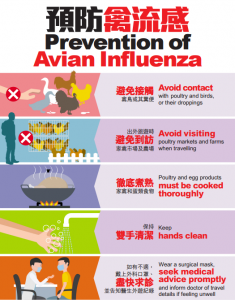By NewsDesk @bactiman63
There has been an increase in human cases of A(H5N6) infections this year, with a bulk of them reported in the second half of the year. This and spread in birds in China and some neighboring countries has prompted the World Health Organization (WHO) to publish a risk assessment last Friday.

There have been 26 A(H5N6) human infections reported in 2021 (25 in China and one in Laos), of those 20 with illness onset dates after 21 June 2021. At least 10 resulted in death.
All sequenced viruses belonged to hemagglutinin genetic clade 2.3.4.4b, a group of viruses that have gradually become more prevalent in birds in China and neighboring countries over the past year.
WHO states it is unclear if the A(H5N6) viruses have enhanced intrinsic zoonotic potential. Although genetic markers known to be associated with mammalian adaptation have been identified sporadically in individual cases following infection, these changes were not consistently present in environmental or poultry viruses and likely reflect intra-host mutations.
While the zoonotic threat remains elevated due to spread of the viruses in birds, based on evidence available so far, the overall pandemic risk is considered not significantly changed in comparison to previous years.
Subscribe to Outbreak News TV on YouTube
Minimizing the risk to humans largely depends on decreasing virus circulation in poultry, reducing the amount of virus in environments at the animal-human interface (i.e., live bird markets and farms) and mitigating exposure to potentially infected birds.
WHO recommends that countries, particularly National Influenza Centers and other influenza laboratories associated with the Global Influenza Surveillance and Response System (GISRS), remain vigilant for the possibility of zoonotic infections.
- Philippines: Experts warn of leptospirosis threat with heavy La Niña rains
- Pakistan: Punjab dengue death toll now 118 as 6 more deaths are recorded
- Sweden: Salmonella Coeln outbreak declared over, Likely linked to sprouts
- Philippines COVID-19 update: Case count, Delta variant and vaccines
- Ireland: H5N1 avian influenza confirmed in Monaghan turkey flock
- Germany: Current COVID-19 situation a ‘national emergency’, New cases up 60% in past 2 weeks
- CDC Expands Eligibility for COVID-19 Booster Shots to All Adults
- Bird flu outbreak reported in Bashkiria, Russia


2 thoughts on “H5N6 avian influenza: WHO urges countries to remain vigilant”